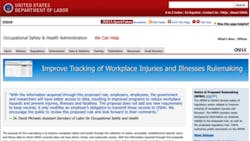The federal Occupational Safety and Health Administration proposed a revision to rules covering the process for employers to report workplace injuries and illnesses, explaining the purpose is to improve workplace safety and health by improving tracking of such incidents.
The general public has 90 days, until February 6, 2014, to submit comments in writing regarding the proposed new rule. On January 9, 2014, a public meeting on the hearing will take place in Washington, DC.
OSHA is proposing to revise current recordkeeping regulations to add requirements for the electronic submission of injury and illness information that employers are already required to keep under existing standards, Part 1904. The first proposed new requirement is for establishments with more than 250 employees (and who are already required to keep records) to electronically submit the records on a quarterly basis to OSHA.
Also, establishments with 20 or more employees in certain industries with high injury and illness rates would be required to submit electronically only their summary of work-related injuries and illnesses to OSHA once a year.
Currently, many firms report this information to OSHA under OSHA’s Data Initiative.
The agency explained that the proposed rule change was developed from ideas that followed several “stakeholder meeting” OSHA conducted in 2010, concerning electronic submission of establishment-specific injury and illness data.
Eventually, OSHA would post the data online, explaining in its announcement that “timely, establishment-specific injury and illness data will help OSHA target its compliance-assistance and enforcement resources more effectively by identifying workplaces where workers are at greater risk, and enable employers to compare their injury rates with others in the same industry.”
OSHA also related the proposed changes to the recent release of by the Bureau of Labor Statistics of its annual Occupational Injuries and Illnesses report for 2012, which estimated 3 million workplace injuries last year.
“Three million injuries are three million too many,” stated Dr. David Michaels, assistant Secretary of Labor for Occupational Safety and Health. “With the changes being proposed in this rule, employers, employees, the government and researchers will have better access to data that will encourage earlier abatement of hazards and result in improved programs to reduce workplace hazards and prevent injuries, illnesses and fatalities.
“The proposal does not add any new requirement to keep records,” Michaels emphasized. “It only modifies an employer’s obligation to transmit these records to OSHA.”
About the Author
Robert Brooks
Content Director
Robert Brooks has been a business-to-business reporter, writer, editor, and columnist for more than 20 years, specializing in the primary metal and basic manufacturing industries. His work has covered a wide range of topics, including process technology, resource development, material selection, product design, workforce development, and industrial market strategies, among others.
